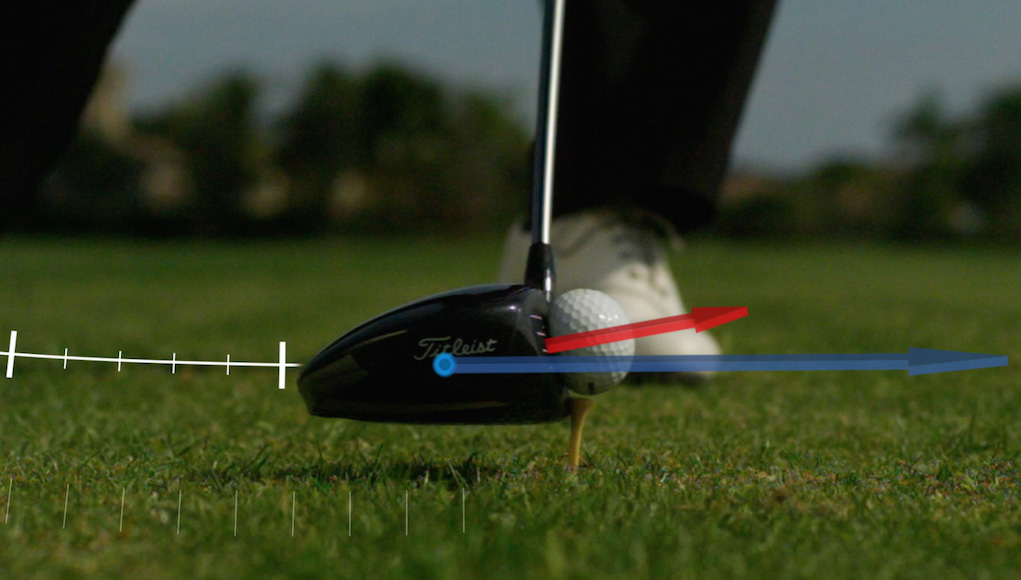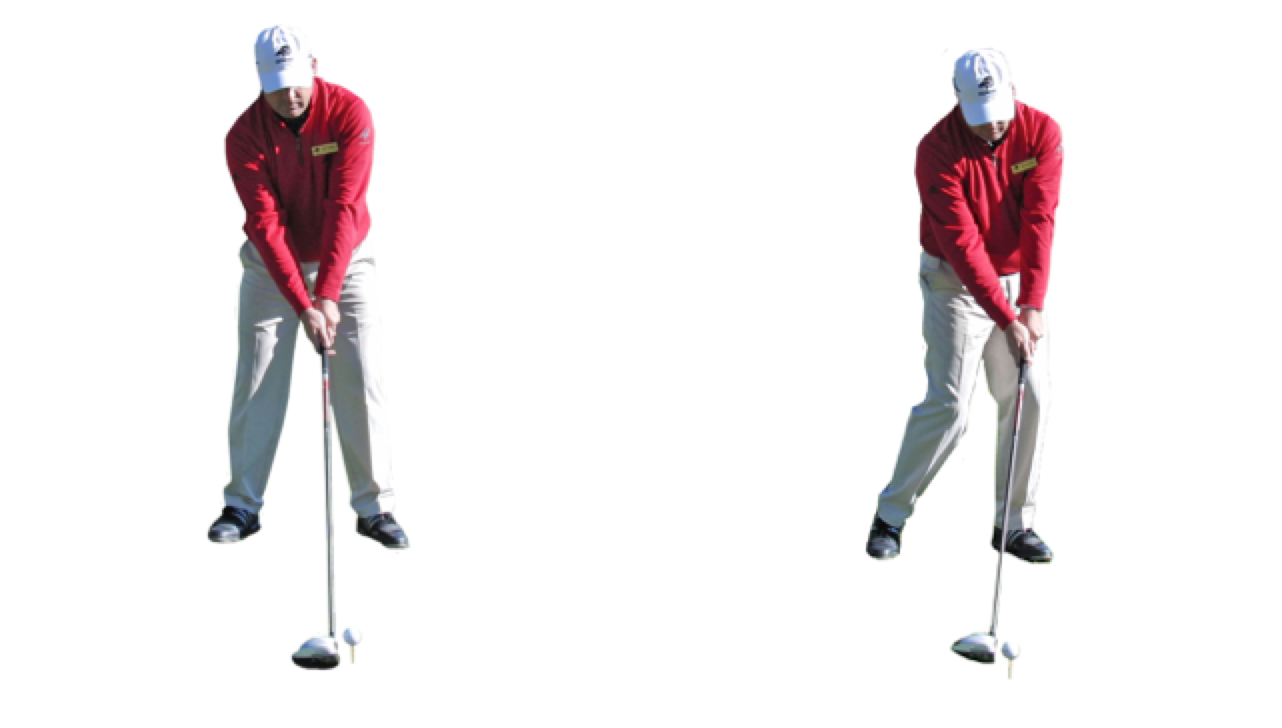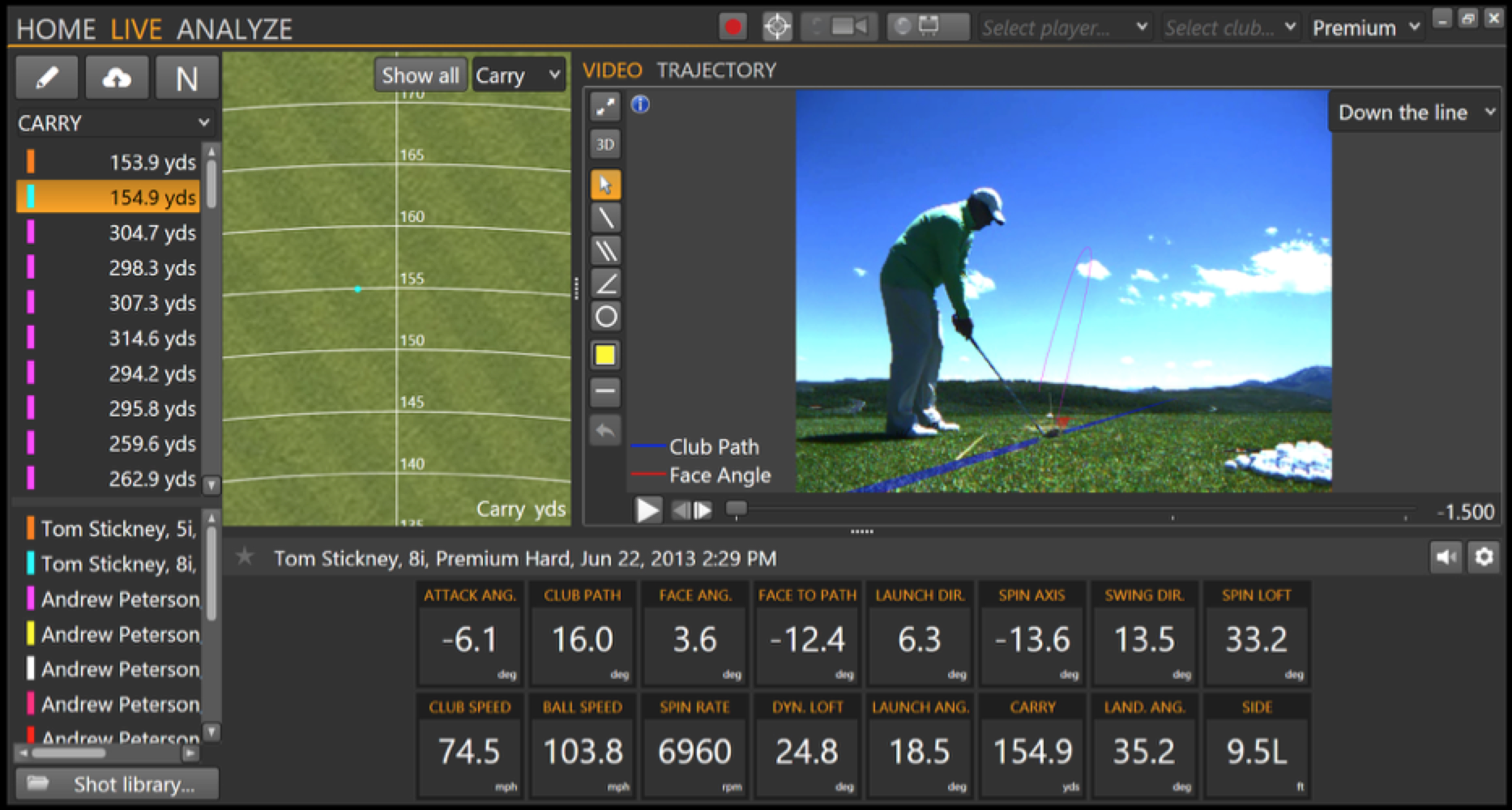Instruction
3 keys you need to understand about impact to play better golf

Impact is the point where the golf ball is programmed by your swing to fly high or low, with curvature or dead straight. Most golfers don’t understand exactly how the relationship between the club head and the golf ball at impact determines how your golf ball flies in the air, however, so in this article I will dissect what happens at the moment of impact. After reading this, hopefully you will have a better idea of what the true goal of a golf swing is, and how you can produce greater consistency in your game.
Here are 3 keys you need to understand about impact to play better golf.
1. Your address position and impact position are NOT the same

The address position (left) and the impact position (right).
It always amazes me how many golf magazine articles say something like, “See how the impact position mirrors the address position.” This is simply not the case.
A Tour Professional’s body at address has certain fundamental characteristics that we all know: a semi-bent left wrist, a flat right wrist, an almost perpendicular angle of their shaft to the ground, shoulders and hips that are somewhat square, and a spine that is tilted a touch to the right of center, as well as forward from the hips.
But at the impact position, all these characteristics change. The only thing that stays the same is the golf ball; it’s still sitting on the tee or on the ground. If you’re trying to re-create your address position at impact, you’re more than likely “quitting” on the shot, which will cause you to lose lag, distance, and consistency every time.
2. The Difference Between Impact and Golf Ball “Separation”
Impact is the point where the club first touches the ball. It’s during this time that the ball briefly adheres to the club face — for about 0.75 inches — as the clubhead moves in its orbit through impact. “Separation” occurs very rapidly after this.
Separation is the point when the ball rebounds off the clubface, and it’s here that the ball is programmed how to react during its flight. Most players believe you must impact the ball with a square clubface, and hit the back of the ball while the clubhead moves down your intended target line. That’s not the case. We now understand that doing so is incorrect, and will produce inadequate impact alignments. My last key will explain what’s truly important about impact: face-to-path differences.
3. Face-to-Path Differences Controls Curvature

The face-to-path ratio for this swing was -12.4, creating a draw. As you can see, the club path was well right of the face angle at impact.
Thanks to Trackman, we now understand why a golf ball flies the way it does. Assuming you hit the center of the club face, shot curvature is created by the difference between the club face and the club path at impact, and is highly influenced by changes in spin loft. The bigger the difference between the face-to-path ratio, the more the ball will want to curve.
As we reduce loft, and thus decrease spin loft, the ball will curve even more. This is why you can have the same face-to-path ratio with a sand wedge and a driver, and the wedge shot will hit the green while the driver shot will finish in the trees. So the key to controlling your golf ball is to:
- Make sure you’re contact shots on the center of the club face (Learn more)
- Manage the differences between your face-to-path (Learn more)
You should now have a better idea of what happens during impact. From there, it will be easier for you to envision what your teaching professional wants you to accomplish, and why.
- LIKE120
- LEGIT19
- WOW4
- LOL4
- IDHT6
- FLOP10
- OB1
- SHANK46
Instruction
Clement: Laid-off or perfect fade? Across-the-line or perfect draw?

Some call the image on the left laid off, but if you are hitting a fade, this could be a perfect backswing for it! Same for across the line for a draw! Stop racking your brain with perceived mistakes and simply match backswing to shot shape!
- LIKE0
- LEGIT0
- WOW0
- LOL0
- IDHT0
- FLOP0
- OB0
- SHANK1
Instruction
The Wedge Guy: The easiest-to-learn golf basic

My golf learning began with this simple fact – if you don’t have a fundamentally sound hold on the golf club, it is practically impossible for your body to execute a fundamentally sound golf swing. I’m still a big believer that the golf swing is much easier to execute if you begin with the proper hold on the club.
As you might imagine, I come into contact with hundreds of golfers of all skill levels. And it is very rare to see a good player with a bad hold on the golf club. There are some exceptions, for sure, but they are very few and very far between, and they typically have beat so many balls with their poor grip that they’ve found a way to work around it.
The reality of biophysics is that the body moves only in certain ways – and the particulars of the way you hold the golf club can totally prevent a sound swing motion that allows the club to release properly through the impact zone. The wonderful thing is that anyone can learn how to put a fundamentally sound hold on the golf club, and you can practice it anywhere your hands are not otherwise engaged, like watching TV or just sitting and relaxing.
Whether you prefer an overlap, interlock or full-finger (not baseball!) grip on the club, the same fundamentals apply. Here are the major grip faults I see most often, in the order of the frequency:
Mis-aligned hands
By this I mean that the palms of the two hands are not parallel to each other. Too many golfers have a weak left hand and strong right, or vice versa. The easiest way to learn how to hold the club with your palms aligned properly is to grip a plain wooden ruler or yardstick. It forces the hands to align properly and shows you how that feels. If you grip and re-grip a yardstick several times, then grip a club, you’ll see that the learning curve is almost immediate.
The position of the grip in the upper/left hand
I also observe many golfers who have the butt of the grip too far into the heel pad of the upper hand (the left hand for right-handed players). It’s amazing how much easier it is to release the club through the ball if even 1/4-1/2″ of the butt is beyond the left heel pad. Try this yourself to see what I mean. Swing the club freely with just your left hand and notice the difference in its release from when you hold it at the end of the grip, versus gripping down even a half inch.
To help you really understand how this works, go to the range and hit shots with your five-iron gripped down a full inch to make the club the same length as your seven-iron. You will probably see an amazing shot shape difference, and likely not see as much distance loss as you would expect.
Too much lower (right) hand on the club
It seems like almost all golfers of 8-10 handicap or higher have the club too far into the palm of the lower hand, because that feels “good” if you are trying to control the path of the clubhead to the ball. But the golf swing is not an effort to hit at the ball – it is a swing of the club. The proper hold on the club has the grip underneath the pad at the base of the fingers. This will likely feel “weak” to you — like you cannot control the club like that. EXACTLY. You should not be trying to control the club with your lower/master hand.
Gripping too tightly
Nearly all golfers hold the club too tightly, which tenses up the forearms and prevents a proper release of the club through impact. In order for the club to move back and through properly, you must feel that the club is controlled by the last three fingers of the upper hand, and the middle two fingers of the lower hand. If you engage your thumbs and forefingers in “holding” the club, the result will almost always be a grip that is too tight. Try this for yourself. Hold the club in your upper hand only, and squeeze firmly with just the last three fingers, with the forefinger and thumb off the club entirely. You have good control, but your forearms are not tense. Then begin to squeeze down with your thumb and forefinger and observe the tensing of the entire forearm. This is the way we are made, so the key to preventing tenseness in the arms is to hold the club very lightly with the “pinchers” — the thumbs and forefingers.
So, those are what I believe are the four fundamentals of a good grip. Anyone can learn them in their home or office very quickly. There is no easier way to improve your ball striking consistency and add distance than giving more attention to the way you hold the golf club.
More from the Wedge Guy
- The Wedge Guy: Golf mastery begins with your wedge game
- The Wedge Guy: Why golf is 20 times harder than brain surgery
- The Wedge Guy: Musings on the golf ball rollback
- LIKE87
- LEGIT13
- WOW6
- LOL1
- IDHT0
- FLOP4
- OB1
- SHANK8
Instruction
Clement: Stop ripping off your swing with this drill!

Not the dreaded headcover under the armpit drill! As if your body is defective and can’t function by itself! Have you seen how incredible the human machine is with all the incredible feats of agility all kinds of athletes are accomplishing? You think your body is so defective (the good Lord is laughing his head off at you) that it needs a headcover tucked under the armpit so you can swing like T-Rex?
- LIKE0
- LEGIT2
- WOW2
- LOL0
- IDHT0
- FLOP0
- OB0
- SHANK2
-

 19th Hole2 weeks ago
19th Hole2 weeks agoDave Portnoy places monstrous outright bet for the 2024 Masters
-

 19th Hole4 days ago
19th Hole4 days agoJustin Thomas on the equipment choice of Scottie Scheffler that he thinks is ‘weird’
-

 19th Hole2 weeks ago
19th Hole2 weeks agoTiger Woods arrives at 2024 Masters equipped with a putter that may surprise you
-

 19th Hole4 days ago
19th Hole4 days ago‘Absolutely crazy’ – Major champ lays into Patrick Cantlay over his decision on final hole of RBC Heritage
-

 19th Hole2 weeks ago
19th Hole2 weeks agoTwo star names reportedly blanked Jon Rahm all week at the Masters
-

 19th Hole1 week ago
19th Hole1 week agoReport: LIV Golf identifies latest star name they hope to sign to breakaway tour
-

 19th Hole2 weeks ago
19th Hole2 weeks agoNeal Shipley presser ends in awkward fashion after reporter claims Tiger handed him note on 8th fairway
-

 19th Hole1 week ago
19th Hole1 week agoBrandel Chamblee has ‘no doubt’ who started the McIlroy/LIV rumor and why

















John Chapman
Jul 25, 2016 at 7:32 am
Why is everyone so happy to just accept the idea of, ‘Assuming you hit the center of the club face’?
The impact location has a huge affect on how the golf ball will fly, without measuring strike you might as well ignore the rest of the club parameters, is there not a technology that measures everything including Impact Location?
RI_Redneck
Jul 22, 2016 at 11:15 pm
I agree that address position and impact position are VERY RARELY the same. However, there is a definite relationship between the two. Otherwise, we wouldn’t see master golfers being so meticulous in their address setup. For instance, I typically aim the clubface as close as possible to my intended starting line and have trained myself to return it to that same alignment (as long as I can keep my dominate right hand in a semi passive state). Had I learned to swing left handed like Phil, it may very well have been quite beneficial to my game.
BT
Dennis Clark
Jul 21, 2016 at 4:58 pm
spot on pro..
ron
Jul 21, 2016 at 4:51 pm
What are your thoughts on the DST theory of pre-setting the impact position by having the club and shaft in one straight line at address with the driver?
larrybud
Jul 21, 2016 at 2:22 pm
Tom, re: separation… how much does it really matter? 3/4″ on the arc is what, MAYBE 1/2 degree in face angle and path?
Ian
Jul 21, 2016 at 2:18 pm
What path-to-face ratio do you need for a straight ball flight?
larrybud
Jul 21, 2016 at 2:20 pm
Depends on your angle of attack, aka the “D Plane”. Take a look at Martin Chuck’s video:
http://blog.trackmangolf.com/hit-perfect-straight-shot/
Craig
Jul 21, 2016 at 1:12 pm
Nice article Tom. I wish you were back in Utah, I’d come see you for a lesson. I don’t get to where you are much…:)
WTF
Jul 21, 2016 at 12:38 pm
“Most players believe you must impact the ball with a square clubface, and hit the back of the ball while the clubhead moves down your intended target line. That’s not the case. We now understand that doing so is incorrect,…”
Really!? So you are NOT supposed to hit the ball with a square face down your intended target line? If not, then what are you supposed to do? I also don’t see how you can even explain hitting the ball anywhere but the back of the ball…Where are you supposed to hit it, the front, right side, left side, on top or below?
Other than that, nothing new in ground breaking moment of impact analysis. Only thing that you really explained well was how the side spin is impacted more by the difference between the face angle and swing path than anything else. That easily explains why a closed face with an over the top swing produces pull hooks, snap hooks, or just a pull.
larrybud
Jul 21, 2016 at 2:21 pm
Read the Trackman “fundamentals”. If I swing 4 degrees left with approx 4 degrees down with a face square to the target, the ball will generally go straight.
Snoopy
Jul 22, 2016 at 3:44 pm
I think his explanation just came out wrong. If the club is moving straight and the face is square, the ball obviously goes straight. But if you make it your “goal” to swing straight like that, you might not get very far because we naturally swing the club in an arc, so things aren’t aligned for long periods of time. Plus, if you keep trying for a perfectly square impact, you might get a two way miss since if you’re “early” or “late”, the club might end up both open and closed. I think his point was that if you consistently attack from one side of the ball (inside or outside), you’ll get a consistent curve direction, which you can then iron out into a pretty straight shot.